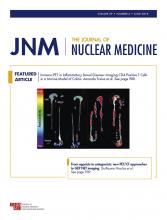Radiopharmaceutical dose estimates to the fetus have been based for many years on the reported placental crossover data and dose estimates of Russell et al. (1,2), which used pregnant female phantoms developed by Oak Ridge National Laboratory (Fig. 1) (3). New fetal dose estimates have now been generated using the new RAdiation Dose Assessment Resource (RADAR) International Commission on Radiological Protection (ICRP) 89 reference female pregnant and nonpregnant models (Fig. 2) (4), as implemented in the OLINDA/EXM 2.0 software (5). Table 1 summarizes the differences in the masses of the fetus, placenta, and uterus between the two sets of models.
Oak Ridge National Laboratory pregnant female models for 3 mo (A), 6 mo (B), and 9 mo (C) of gestation. (Reprinted with permission of (3).)
Rensselaer Polytechnic Institute pregnant female models for 3 mo (left), 6 mo (middle), and 9 mo (right) of gestation (7).
Most maternal and fetal time–activity integrals were taken from Russell et al. (2), to maintain consistency with the previous estimates. Although biokinetic models may have changed somewhat, the previous values were retained. One exception is that dose estimates for 18F-FDG were taken from Zanotti-Fregonara and Stabin (6), as this publication provided a significant update to the older dose estimates, including placental crossover. Other radiopharmaceuticals, not considered by Russell et al., were added; references are given in Supplemental Table 1 (supplemental materials are available at http://jnm.snmjournals.org).
When the literature provides no information on placental crossover, only maternal contributions to fetal dose can be considered. If there is placental crossover, this may underestimate fetal doses, but there is no reliable way to arbitrarily assign placental crossover in the absence of any scientific data. As with the adult/pediatric RADAR radiopharmaceutical dose compendium (5), this article will be maintained in electronic format, allowing for revisions and additions, as needed.
Doses are provided for “early pregnancy” (dose to the nongravid uterus in the RADAR reference adult female model) and to the fetus at 3, 6, and 9 mo of gestation. Uncertainties in using these estimates for a specific subject are considerable, both in the physiology of the radiopharmaceutical kinetics and in the assumed geometry of the maternal and fetal organs. Dose estimates that bracket a given real-life exposure (e.g., for a case at 4 mo of gestation, the 3- and 6-mo values can be applied) should not use sophisticated interpolation methods. Rather, one should look at the dose estimate on either side, take the higher of the two, and round to 1 significant figure to give an estimate to a real patient. For example, if a pregnant woman at 4 mo of gestation is administered 370 MBq of 18F-FDG, the estimated fetal dose from Supplemental Table 1 is 7.0 mGy at 3 mo and 5.2 mGy at 6 mo; an estimate of 5–7 mGy is reasonable and conservative.
DISCLOSURE
No potential conflict of interest relevant to this article was reported.
Footnotes
Published online Dec. 21, 2017.
- © 2018 by the Society of Nuclear Medicine and Molecular Imaging.
REFERENCES
- Received for publication October 24, 2017.
- Accepted for publication November 21, 2017.









